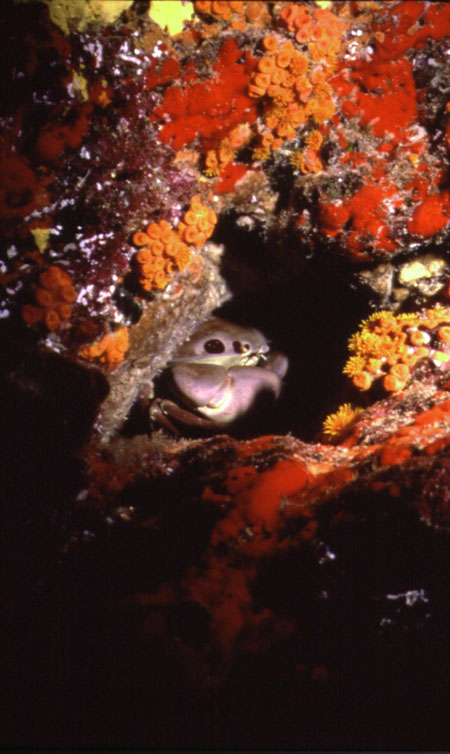Adaptation
When writing on the adaptations of the Paralithodes camtschatica, the main adaptations the red king crab are generally to its environment and habitat, its feeding habits, reproduction, and its interactions between other species. Through these adaptations, the king crab is able to survive and populate the many areas it exists.
The P. camtschatica has a range of environments it lives in, from temperate to polar. Even with this temperature change, the crab’s lifestyle has not been affected in any of these environments, able to live in warmer areas as well as the polar climates as well. The P. camtschatica use enzymes that are adapted to support a stable metabolic rate, keeping catalysis at a normal rate over a variety of temperatures.1 The main environmental factors the red king crabs are most dependent on are a plentiful food source and ability of successful reproduction.2 The red king crabs can also interact better to the environment through the increase in ability of communication. The crabs have compound eyes, letting them see more clearly. They also use their sense of touch, being able to feel around their environment by the antenna on their head. Also, the red king crabs communicate chemically through pheromones, using the chemicals as either a warning signal or a sign by the female implying she is ready to mate.3
Feeding Habits:
Red king crabs eat an assortment of food, foraging anything they may come across, whether a soft sponge, worm, or echinoderm, or a hard mussel or barnacle. Adaptations to this foraging lifestyle include the species mouthparts and claws. They are able to eat is array of organisms because of their ability to crush and hold onto their prey, by their claws, and manipulate and chew their food by their mandibles, maxillae, and maxillipeds.4 Also, because of the adult crab’s strong defense by its carapace, it can wander the depths without much worry of being eaten.5 Metamorphosis and the crab’s different niches for its larvae, juveniles, and adults is a great factor in food abundance, for there is a small, if any competition for food between each group. Because of this, the organisms have a better chance in survival because of the different food sources, the young not competing for the same food of the adults.6
Reproduction:
 The P. camtschatica’s reproductive
system is adapted to its environment through external fertilization and their
clutch size. External fertilization is possible for this species because they
are aquatic and are able to pass the sperm externally without it drying up. The
large clutch size for the red king crab is also important in order to keep
populations high because of the 100,000 to 200,000 larvae hatched, only one of
these typically survive to adulthood.7
This large fatality rate is caused by predation, low food availability, poor
water quality, as well as the many more eternal factors the larvae face.8
The P. camtschatica’s reproductive
system is adapted to its environment through external fertilization and their
clutch size. External fertilization is possible for this species because they
are aquatic and are able to pass the sperm externally without it drying up. The
large clutch size for the red king crab is also important in order to keep
populations high because of the 100,000 to 200,000 larvae hatched, only one of
these typically survive to adulthood.7
This large fatality rate is caused by predation, low food availability, poor
water quality, as well as the many more eternal factors the larvae face.8
Interactions Between Other Species:
The king crab is considered a predator to many species lower on the food chain, including the echinoderms, sponges, and worms, yet they are also prey to many other species. Because of this, adaptations have made it possible for the red king crab to hold its own by the increase in defense and escaping abilities. During the megalops stage, the juvenile crab use podding to increase their survival rate, swarming into massive groups. The adult king crab has a hard carapace covered in spines that keep away predators that are able to consume its younger relatives.9 Its claws also help ward the predators away as well, snapping in defense. Also, king crabs use a scattering technique, that when a predator is near, the crab kicks up mud creating a cloud, making it practically impossible to find the crab, enabling the crab flee from danger.10
